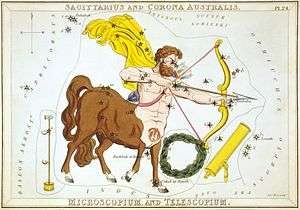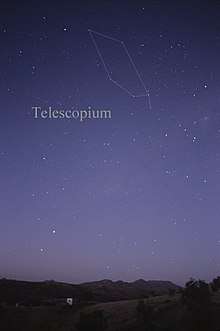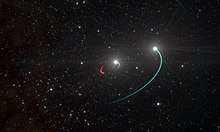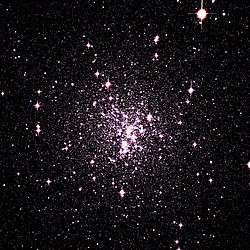Telescopium
Telescopium is a minor constellation in the southern celestial hemisphere, one of twelve named in the 18th century by French astronomer Nicolas-Louis de Lacaille and one of several depicting scientific instruments. Its name is a Latinized form of the Greek word for telescope. Telescopium was later much reduced in size by Francis Baily and Benjamin Gould.
| Constellation | |
 | |
| Abbreviation | Tel |
|---|---|
| Genitive | Telescopii |
| Pronunciation | /ˌtɛlɪˈskoʊpiəm/, genitive /ˌtɛlɪˈskoʊpi.aɪ/ |
| Symbolism | the Telescope |
| Right ascension | 19h |
| Declination | −50° |
| Quadrant | SQ4 |
| Area | 252 sq. deg. (57th) |
| Main stars | 2 |
| Bayer/Flamsteed stars | 13 |
| Stars with planets | 0 |
| Stars brighter than 3.00m | 0 |
| Stars within 10.00 pc (32.62 ly) | 2 |
| Brightest star | α Tel (3.49m) |
| Messier objects | 0 |
| Bordering constellations |
|
| Visible at latitudes between +40° and −90°. Best visible at 21:00 (9 p.m.) during the month of August. | |
The brightest star in the constellation is Alpha Telescopii, a blue-white subgiant with an apparent magnitude of 3.5, followed by the orange giant star Zeta Telescopii at magnitude 4.1. Eta and PZ Telescopii are two young star systems with debris disks and brown dwarf companions. Telescopium hosts two unusual stars with very little hydrogen that are likely to be the result of two merged white dwarfs: PV Telescopii, also known as HD 168476, is a hot blue extreme helium star, while RS Telescopii is an R Coronae Borealis variable. RR Telescopii is a cataclysmic variable that brightened as a nova to magnitude 6 in 1948. Telescopium also hosts the first known visible star system with a black hole, QV Telescopii (HR 6819), which appears as a variable star with magnitude 5.32 to 5.39.
History

Telescopium was introduced in 1751–52 by Nicolas-Louis de Lacaille with the French name le Telescope,[1] depicting an aerial telescope,[2] after he had observed and catalogued 10,000 southern stars during a two-year stay at the Cape of Good Hope. He devised 14 new constellations in uncharted regions of the Southern Celestial Hemisphere not visible from Europe. All but one honored instruments that symbolised the Age of Enlightenment.[3] Covering 40 degrees of the night sky,[2] the telescope stretched out northwards between Sagittarius and Scorpius.[4] Lacaille had Latinised its name to Telescopium by 1763.[1]
The constellation was known by other names. It was called Tubus Astronomicus in the eighteenth century, during which time three constellations depicting telescopes were recognised—Tubus Herschelii Major between Gemini and Auriga and Tubus Herschelii Minor between Taurus and Orion, both of which had fallen out of use by the nineteenth century.[5] Johann Bode called it the Astronomische Fernrohr in his 1805 Gestirne and kept its size, but later astronomers Francis Baily and Benjamin Gould subsequently shrank its boundaries.[6] The much-reduced constellation lost several brighter stars to neighbouring constellations: Beta Telescopii became Eta Sagittarii, which it had been before Lacaille placed it in Telescopium,[7] Gamma was placed in Scorpius and renamed G Scorpii by Gould,[7] Theta Telescopii reverted to its old appellation of d Ophiuchi,[7] and Sigma Telescopii was placed in Corona Australis. Initially uncatalogued, the latter is now known as HR 6875.[7] The original object Lacaille had named Eta Telescopii—the open cluster Messier 7—was in what is now Scorpius, and Gould used the Bayer designation for a magnitude 5 star, which he felt warranted a letter.[7]
Characteristics

A small constellation, Telescopium is bordered by Sagittarius and Corona Australis to the north, Ara to the west, Pavo to the south, and Indus to the east, cornering on Microscopium to the northeast. The three-letter abbreviation for the constellation, as adopted by the International Astronomical Union in 1922, is "Tel".[8] The official constellation boundaries, as set by Eugène Delporte in 1930, are defined by a quadrilateral. In the equatorial coordinate system, the right ascension coordinates of these borders lie between 18h 09.1m and 20h 29.5m, while the declination coordinates are between −45.09° and −56.98°.[9] The whole constellation is visible to observers south of latitude 33°N.[10][lower-alpha 1]
Features
Stars
Within the constellation's borders, there are 57 stars brighter than or equal to apparent magnitude 6.5.[lower-alpha 2][10] With a magnitude of 3.5, Alpha Telescopii is the brightest star in the constellation. It is a blue-white subgiant of spectral type B3IV which lies around 250 light-years away.[12] It is radiating nearly 800 times the Sun's luminosity, and is estimated to be 5.2±0.4 times as massive and have 3.3±0.5 times the Sun's radius.[13] Close by Alpha Telescopii are the two blue-white stars sharing the designation of Delta Telescopii. Delta¹ Telescopii is of spectral type B6IV and apparent magnitude 4.9,[14] while Delta² Telescopii is of spectral type B3III and magnitude 5.1.[15] They form an optical double,[16] as the stars are estimated to be around 710 and 1190 light-years away respectively.[17] The faint (magnitude 12.23) Gliese 754, a red dwarf of spectral type M4.5V, is one of the nearest 100 stars to Earth at 19.3 light-years distant.[18] Its eccentric orbit around the Galaxy indicates that it may have originated in the Milky Way's thick disk.[19]
At least four of the fifteen stars visible to the unaided eye are orange giants of spectral class K.[20] The second brightest star in the constellation—at apparent magnitude 4.1—is Zeta Telescopii, an orange subgiant of spectral type K1III-IV.[21] Around 1.53 times as massive as the Sun, it shines with 512 times its luminosity.[22] Located 127 light years away from Earth, it has been described as yellow[16] or reddish in appearance.[23] Epsilon Telescopii is a binary star system:[24] the brighter component, Epsilon Telescopii A, is an orange giant of spectral type K0III with an apparent magnitude of +4.52,[25] while the 13th magnitude companion, Epsilon Telescopii B, is 21 arcseconds away from the primary, and just visible with a 15 cm aperture telescope on a dark night.[24] The system is 417 light-years away.[26] Iota Telescopii and HD 169405—magnitude 5 orange giants of spectral types K0III and K0.5III respectively[27][28]—make up the quartet.[20] They are around 370 and 497 light-years away from the Sun respectively.[26] Another ageing star, Kappa Telescopii is a yellow giant with a spectral type G9III and apparent magnitude of 5.18.[29] Around 1.87 billion years old, this star of around 1.6 solar masses has swollen to 11 times the Sun's diameter.[30] It is approximately 293 light-years from Earth, and is another optical double.[24]
Xi Telescopii is an irregular variable star that ranges between magnitudes 4.89 and 4.94.[31] Located 1079 light-years distant, it is a red giant of spectral type M2III that has a diameter around 5.6 times the Sun's,[32] and a luminosity around 2973 times that of the Sun.[26] Another irregular variable, RX Telescopii is a red supergiant that varies between magnitudes 6.45 and 7.47,[33] just visible to the unaided eye under good viewing conditions. BL Telescopii is an Algol-like eclipsing binary system that varies between apparent magnitudes 7.09 and 9.08 over a period of just over 778 days (2 years 48 days).[34] The primary is a yellow supergiant that is itself intrinsically variable.[35] Dipping from its baseline magnitude of 9.6 to 16.5,[36] RS Telescopii is a rare R Coronae Borealis variable—an extremely hydrogen-deficient supergiant thought to have arisen as the result of the merger of two white dwarfs; fewer than 100 have been discovered as of 2012.[37] The dimming is thought to be caused by carbon dust expelled by the star. As of 2012, four dimmings have been observed.[37] PV Telescopii is a class B-type (blue) extreme helium star that is the prototype of a class of variables known as PV Telescopii variables. First discovered in 1952, it was found to have a very low level of hydrogen. One theory of its origin is that it is the result of a merger between a helium- and a carbon-oxygen white dwarf. If the combined mass does not exceed the Chandrasekhar limit, the former will accrete onto the latter star and ignite to form a supergiant. Later this will become an extreme helium star before cooling to become a white dwarf.[38]


While RR Telescopii, also designated Nova Telescopii 1948, is often called a slow nova, it is now classified as a symbiotic nova system composed of an M5III pulsating red giant and a white dwarf; between 1944 and 1948 it brightened by about 7 magnitudes before being noticed at apparent magnitude 6.0 in mid-1948.[39] It has since faded slowly to about apparent magnitude 12.[40] QS Telescopii is a binary system composed of a white dwarf and main sequence donor star, in this case the two are close enough to be tidally locked, facing one another. Known as polars, material from the donor star does not form an accretion disk around the white dwarf, but rather streams directly onto it.[41] This is due to the presence of the white dwarf's strong magnetic field.[42]
Although no star systems in Telescopium have confirmed planets, several have been found to have brown dwarf companions. A member of the 12-million-year-old Beta Pictoris moving group of stars that share a common proper motion through space,[43] Eta Telescopii is a young white main sequence star of magnitude 5.0 and spectral type A0V.[44] It has a debris disk and brown dwarf companion of spectral type M7V or M8V that is between 20 and 50 times as massive as Jupiter.[43] The system is complex, as it has a common proper motion with (and is gravitationally bound to) the star HD 181327, which has its own debris disk.[45] This latter star is a yellow-white main sequence star of spectral type F6V of magnitude 7.0.[46] PZ Telescopii is another young star with a debris disk and substellar brown dwarf companion, though at 24 million years of age appears too old to be part of the Beta Pictoris moving group.[47] HD 191760 is a yellow subgiant—a star that is cooling and expanding off the main sequence—of spectral type G3IV/V. Estimated to be just over four billion years old, it is slightly (1.1 to 1.3 times) more massive as the Sun, 2.69 times as luminous, and has around 1.62 times its radius. Using the High Accuracy Radial Velocity Planet Searcher (HARPS) instrument on the ESO 3.6 m Telescope, it was found to have a brown dwarf around 38 times as massive as Jupiter orbiting at an average distance of 1.35 AU with a period of 505 days. This is an unusually close distance from the star, within a range that has been termed the brown-dwarf desert.[48]
Black hole
Telescopium is also host to the first known visible star system with a black hole. QV Telescopii, also designated HR 6819, is a triple star system, which is visible to the unaided eye as a variable star with apparent magnitude 5.32 to 5.39. It is located in Telescopium near its SW corner with Ara and Pavo. The hierarchical triple star system consists of two B-type giant stars, the inner with spectral types B3III and the outer Be, as well as one unseen stellar-mass companion in the inner binary with an orbital period of 40.33 days. This unseen companion is inferred to be a non-accreting stellar-mass black hole of at least 4 M☉. At a distance of approximately 1,120 light-years, QV Telescopii is, as of 2020, the closest known black hole to Earth and the only known visible star system to contain a black hole.[49]
Deep sky objects
The globular cluster NGC 6584 lies near Theta Arae and is 45,000 light-years distant from Earth.[23] It is an Oosterhoff type I cluster, and contains at least 69 variable stars, most of which are RR Lyrae variables.[50] The planetary nebula IC 4699 is of 13th magnitude and lies midway between Alpha and Epsilon Telescopii.[23]
IC 4889 is an elliptical galaxy of apparent magnitude 11.3, which can be found 2 degrees north-north-west of 5.3-magnitude Nu Telescopii. Observing it through a 40 cm telescope will reveal its central region and halo.[51] The Telescopium group is group of twelve galaxies spanning three degrees in the northeastern part of the constellation, lying around 37 megaparsecs (120 million light-years) from our own galaxy.[23] The brightest member is the elliptical galaxy NGC 6868,[52] and to the west lies the spiral galaxy (or, perhaps, lenticular galaxy) NGC 6861.[23] These are the brightest members of two respective subgroups within the galaxy group, and are heading toward a merger in the future.[52] Occupying an area of around 4' × 2', NGC 6845 is an interacting system of four galaxies—two spiral and two lenticular galaxies—that is estimated to be around 88 megaparsecs (287 million light-years) distant.[53] SN 2008da was a type II supernova observed in one of the spiral galaxies, NGC 6845A, in June 2008.[54] SN 1998bw was a luminous supernova observed in the spiral arm of the galaxy ESO184-G82 in April 1998, and is notable in that it is highly likely to be the source of the gamma-ray burst GRB 980425.[lower-alpha 3] [55]
Notes
- While parts of the constellation technically rise above the horizon to observers between 33°N and 44°N, stars within a few degrees of the horizon are to all intents and purposes unobservable.[10]
- Objects of magnitude 6.5 are among the faintest visible to the unaided eye in suburban-rural transition night skies.[11]
- chances of signals being unrelated is around 1 in 10,000.[55]
References
Citations
- Ridpath, Star Tales Lacaille.
- Wagman 2003, p. 299.
- Wagman 2003, pp. 6–7.
- Ridpath, Star Tales Telescopium.
- Ellis 1997.
- Allen 1963, p. 414.
- Wagman 2003, p. 300.
- Russell 1922, p. 469.
- IAU, The Constellations, Telescopium.
- Ridpath, Constellations: Lacerta–Vulpecula.
- The Bortle Dark-Sky Scale.
- Kaler, Alpha Telescopii.
- Hubrig 2009.
- SIMBAD HR 6934.
- SIMBAD HR 6938.
- Ridpath & Tirion 2007, pp. 242–43.
- van Leeuwen 2007.
- SIMBAD LHS 60.
- Innanen 2010.
- Bagnall 2012, pp. 434–35.
- Gray et al. 2006.
- Liu et al. 2007.
- Streicher 2009, pp. 168–71.
- Ferreira 2009, pp. 166–67.
- SIMBAD Epsilon Telescopii.
- McDonald et al. 2012.
- SIMBAD Iota Telescopii.
- SIMBAD HD 169405.
- SIMBAD Kappa Telescopii.
- da Silva et al. 2006.
- AAVSO NSV 12783.
- Pasinetti Fracassini et al. 2001.
- AAVSO RX Telescopii.
- AAVSO BL Telescopii.
- Zsoldos 1994.
- AAVSO RS Telescopii.
- Tisserand 2012.
- Pandey 2006.
- Robinson 1975.
- Light Curve Generator.
- Gerke 2006.
- Traulsen 2011.
- Smith 2009.
- SIMBAD Eta Telescopii.
- Neuhäuser 2011.
- SIMBAD HD 181327.
- Jenkins 2012.
- Jenkins 2009.
- Rivinius 2020.
- Toddy et al. 2012, pp. 63–71.
- Bakich 2010, p. 277.
- Machacek et al. 2010, pp. 1316–32.
- Gordon 2003.
- Morrell 2008.
- galama 1998.
Sources
- Allen, Richard Hinckley (1963) [1899]. Star Names: Their Lore and Meaning (reprint ed.). New York City: Dover Publications. ISBN 978-0-486-21079-7.CS1 maint: ref=harv (link)
- Bagnall, Philip M. (2012). The Star Atlas Companion: What You Need to Know about the Constellations. New York: Springer. ISBN 978-1-4614-0830-7.CS1 maint: ref=harv (link)
- Bakich, Michael E. (2010). 1,001 Celestial Wonders to See Before You Die. Springer Science + Business Media. ISBN 978-1-4419-1777-5.CS1 maint: ref=harv (link)
- da Silva, L.; Girardi, L.; Pasquini, L.; Setiawan, J.; von der Lühe, O.; de Medeiros, J. R.; Hatzes, A.; Döllinger, M. P.; Weiss, A. (2006). "Basic Physical Parameters of a Selected Sample of Evolved Stars". Astronomy & Astrophysics. 458 (2): 609–23. arXiv:astro-ph/0608160. Bibcode:2006A&A...458..609D. doi:10.1051/0004-6361:20065105.
- Ellis, Edward (1997). "Impressions of Cape skies – April 1995". Journal of the British Astronomical Association. 107 (1): 31–33. Bibcode:1997JBAA..107...31E.CS1 maint: ref=harv (link)
- Ferreira, Lucas (2009). "Deepsky Delights: Double Stars in Telescopium". Monthly Notes of the Astronomical Society of Southern Africa. 68 (4): 166–67. Bibcode:2009MNSSA..68..166F. ISSN 0024-8266.CS1 maint: ref=harv (link)
- Galama, T. J.; Vreeswijk, P.M.; van Paradijs, J.; Kouveliotou, C.; Augusteijn, T.; Böhnhardt, H.; Brewer, J.P.; Doublier, V.; Gonzalez, J.-F.; Leibundgut, B.; Lidman, C.; Hainaut, O.R.; Patat, F.; Heise, J.; in't Zand, J.; Hurley, K.; Groot, P.J.; Strom, R.G.; Mazzali, P.A.; Iwamoto, K.; Nomoto, K.; Umeda, H.; Nakamura, T.; Young, T. R.; Suzuki, T.; Shigeyama, T.; Koshut, T.; Kippen, M.; Robinson, C.; de Wildt, P.; Wijers, R.A.M.J.; Tanvir, N.; Greiner, J.; Pian, E.; Palazzi, E.; Frontera, F.; Masetti, N.; Nicastro, L.; Feroci, M.; Costa, E.; Piro, L.; Peterson, B.A.; Tinney, C.; Boyle, B.; Cannon, R.; Stathakis, R.; Sadler, E.; Begam, M. C.; Ianna, P. (1998). "An Unusual Supernova in the Error Box of the γ-ray Burst of 25 April 1998". Nature. 395 (6703): 670–72. arXiv:astro-ph/9806175. Bibcode:1998Natur.395..670G. doi:10.1038/27150.
- Gerke, Jill R.; Howell, Steve B.; Walter, Frederick M. (2006). "Polars Changing State: Multiwavelength Long‐Term Photometry and Spectroscopy of QS Telescopii, V834 Centauri, and BL Hydri". Publications of the Astronomical Society of the Pacific. 118 (843): 678–86. arXiv:astro-ph/0603097. Bibcode:2006PASP..118..678G. doi:10.1086/503753.
- Gordon, Scott; Koribalski, Bärbel; Jones, Keith (2003). "Australia Telescope Compact Array H I observations of the NGC 6845 galaxy group". Monthly Notices of the Royal Astronomical Society. 342 (3): 939–50. arXiv:astro-ph/0303187. Bibcode:2003MNRAS.342..939G. doi:10.1046/j.1365-8711.2003.06606.x.
- Gray, R. O.; Corbally, C. J.; Garrison, R. F.; McFadden, M. T.; Bubar, E. J.; McGahee, C. E.; O'Donoghue, A. A.; Knox, E. R. (2006). "Contributions to the Nearby Stars (NStars) Project: spectroscopy of stars earlier than M0 within 40 pc-The Southern Sample". The Astronomical Journal. 132 (1): 161–70. arXiv:astro-ph/0603770. Bibcode:2006AJ....132..161G. doi:10.1086/504637.
- Hubrig, S.; Briquet, M.; De Cat, P.; Schöller, M.; Morel, T.; Ilyin, I. (April 2009). "New magnetic field measurements of β Cephei stars and slowly pulsating B stars". Astronomische Nachrichten. 330 (4): 317–329. arXiv:0902.1314. Bibcode:2009AN....330..317H. doi:10.1002/asna.200811187.
- Innanen, K. A.; Flynn, C. (2010). "The Radial Velocity, Space Motion, and Galactic Orbit of GJ 754". Journal of the Royal Astronomical Society of Canada. 104 (6): 223–24. Bibcode:2010JRASC.104..223I.
- Jenkins, J.S.; Pavlenko, Y. V.; Ivanyuk, O.; Gallardo, J.; Jones, M. I.; Day-Jones, A. C.; Jones, H. R. A.; Ruiz, M. T.; Pinfield, D. J.; Yakovina, L. (2012). "Benchmark Cool Companions: Ages and Abundances for the PZ Telescopii System". Monthly Notices of the Royal Astronomical Society. 420 (4): 3587–98. arXiv:1111.7001. Bibcode:2012MNRAS.420.3587J. doi:10.1111/j.1365-2966.2011.20280.x.
- Jenkins, J. S.; Jones, H.R.A.; Goździewski, K.; Migaszewski, C.; Barnes, J. R.; Jones, M. I.; Rojo, P.; Pinfield, D. J.; Day-Jones, A.C.; Hoyer, S. (2009). "First Results From the Calan–Hertfordshire Extrasolar Planet Search: Exoplanets and the Discovery of an Eccentric Brown Dwarf in the Desert". Monthly Notices of the Royal Astronomical Society. 398 (2): 911–17. arXiv:0905.2985. Bibcode:2009MNRAS.398..911J. doi:10.1111/j.1365-2966.2009.15097.x.
- Liu, Y. J.; Zhao, G.; Shi, J. R.; Pietrzyński, G.; Gieren, W. (2007). "The abundances of nearby red clump giants". Monthly Notices of the Royal Astronomical Society. 382 (2): 553–66. Bibcode:2007MNRAS.382..553L. doi:10.1111/j.1365-2966.2007.11852.x.
- Machacek, M. E.; O'Sullivan, E.; Randall, S. W.; Jones, C.; Forman, W. R. (2010). "The Mysterious Merger of NGC 6868 and NGC 6861 in the Telescopium Group". The Astrophysical Journal. 711 (2): 1316–1332. arXiv:1001.2567. Bibcode:2010ApJ...711.1316M. doi:10.1088/0004-637X/711/2/1316.
- McDonald, I.; Zijlstra, A. A.; Boyer, M. L. (2012). "Fundamental Parameters and Infrared Excesses of Hipparcos Stars". Monthly Notices of the Royal Astronomical Society. 427 (1): 343–57. arXiv:1208.2037. Bibcode:2012MNRAS.427..343M. doi:10.1111/j.1365-2966.2012.21873.x.
- Morrell, N. (2008). "Supernova 2008da in NGC 6845A". Central Bureau Electronic Telegrams. 1412: 1. Bibcode:2008CBET.1412....1M.
- Neuhäuser, R.; Ginski, C.; Schmidt, T. O. B.; Mugrauer, M. (2011). "Further Deep Imaging of HR 7329 A (η Tel A) and its Brown Dwarf Companion B". Monthly Notices of the Royal Astronomical Society. 416 (2): 1430–35. arXiv:1106.1388. Bibcode:2011MNRAS.416.1430N. doi:10.1111/j.1365-2966.2011.19139.x.
- Pandey, Gajendra; Lambert, David L.; Jeffery, C. Simon; Rao, N. Kameswara (2006). "An Analysis of Ultraviolet Spectra of Extreme Helium Stars and New Clues to Their Origins". The Astrophysical Journal. 638 (1): 454–71. arXiv:astro-ph/0510161. Bibcode:2006ApJ...638..454P. doi:10.1086/498674.
- Pasinetti Fracassini, L. E.; Pastori, L.; Covino, S.; Pozzi, A. (2001). "Catalogue of Apparent Diameters and Absolute Radii of Stars (CADARS) – Third edition – Comments and statistics". Astronomy & Astrophysics. 367 (2): 521–24. arXiv:astro-ph/0012289. Bibcode:2001A&A...367..521P. doi:10.1051/0004-6361:20000451.
- Ridpath, Ian; Tirion, Wil (2007). Stars and Planets Guide. Princeton, New Jersey: Princeton University Press. ISBN 978-0-691-13556-4.CS1 maint: ref=harv (link)
- Robinson, E. L. (1975). "Preeruption Light Curves of Novae". The Astronomical Journal. 80 (7): 515. Bibcode:1975AJ.....80..515R. doi:10.1086/111774.
- Russell, Henry Norris (October 1922). "The new international symbols for the constellations". Popular Astronomy. 30: 469. Bibcode:1922PA.....30..469R.CS1 maint: ref=harv (link)
- Smith, R.; Churcher, L. J.; Wyatt, M. C.; Moerchen, M. M.; Telesco, C. M. (2009). "Resolved Debris Disc Emission around Eta Telescopii: a Young Solar System or Ongoing Planet Formation?" (PDF). Astronomy & Astrophysics. 493: 299–308. arXiv:0810.5087. Bibcode:2009A&A...493..299S. doi:10.1051/0004-6361:200810706.
- Streicher, Magda (2009). "Deepsky Delights: A Spyglass Telescope". Monthly Notes of the Astronomical Society of Southern Africa. 68 (4): 168–69. Bibcode:2009MNSSA..68..168S. ISSN 0024-8266.CS1 maint: ref=harv (link)
- Tisserand; Clayton; Welch; Pilecki; Wyrzykowski; Kilkenny (2012). "The Ongoing Pursuit of R Coronae Borealis Stars: ASAS-3 Survey Strikes Again". Astronomy & Astrophysics. 551: 22. arXiv:1211.2475. Bibcode:2013A&A...551A..77T. doi:10.1051/0004-6361/201220713. A77.
- Toddy, Joseph M.; Johnson, Elliott W.; Darragh, Andrew N.; Murphy, Brian W. (2012). "New Variable Stars in the Globular Cluster NGC 6584". Journal of the Southeastern Association for Research in Astronomy. 6: 63–71. arXiv:1205.1034. Bibcode:2012JSARA...6...63T.
- Traulsen, I.; Reinsch, K.; Schwope, A. D.; Burwitz, V.; Dreizler, S.; Schwarz, R.; Walter, F. M., I.; Reinsch, K.; Schwope, A. D.; Burwitz, V.; Dreizler, S.; Schwarz, R.; Walter, F. M. (2011). "XMM-Newton observations of the X-ray soft polar QS Telescopii". Astronomy and Astrophysics. 529 (A116): 7. arXiv:1103.4575. Bibcode:2011A&A...529A.116T. doi:10.1051/0004-6361/201016352.CS1 maint: multiple names: authors list (link)
- van Leeuwen, F. (November 2007). "Validation of the new Hipparcos reduction". Astronomy and Astrophysics. 474 (2): 653–64. arXiv:0708.1752. Bibcode:2007A&A...474..653V. doi:10.1051/0004-6361:20078357.
- Wagman, Morton (2003). Lost Stars: Lost, Missing and Troublesome Stars from the Catalogues of Johannes Bayer, Nicholas Louis de Lacaille, John Flamsteed, and Sundry Others. Blacksburg, Virginia: The McDonald & Woodward Publishing Company. ISBN 978-0-939923-78-6.CS1 maint: ref=harv (link)
- Zsoldos, E. (1994). "The pulsations of yellow semi-regular variables II. The F supergiant in the high-latitude binary BL Telescopii". Astronomy and Astrophysics. 286: 870–74. Bibcode:1994A&A...286..870Z.
Online sources
- AAVSO. "AAVSO Light Curve Generator". Retrieved 5 September 2013.
- Otero, Sebastian Alberto (31 July 2006). "BL Telescopii". AAVSO Website. American Association of Variable Star Observers. Retrieved 14 July 2014.
- Otero, Sebastian Alberto (13 February 2014). "RS Telescopii". AAVSO Website. American Association of Variable Star Observers. Retrieved 3 July 2014.
- Otero, Sebastian Alberto (11 November 2011). "RX Telescopii". AAVSO Website. American Association of Variable Star Observers. Retrieved 26 June 2014.
- Watson, Christopher (3 May 2013). "NSV 12783". AAVSO Website. American Association of Variable Star Observers. Retrieved 2 July 2014.
- Bortle, John E. (February 2001). "The Bortle Dark-Sky Scale". Sky & Telescope. Sky Publishing Corporation. Retrieved 29 November 2014.
- "Telescopium, constellation boundary". The Constellations. International Astronomical Union. Retrieved 29 September 2012.
- Kaler, Jim. "Alpha Telescopii". Stars. University of Illinois. Retrieved 29 September 2012.
- Ian Ridpath. "Lacaille's Southern Planisphere of 1756". Star Tales. self-published. Retrieved 2 July 2014.
- Ian Ridpath. "Constellations: Lacerta–Vulpecula". Star Tales. self-published. Retrieved 21 June 2014.
- Ridpath, Ian (1988). "Telescopium". Star Tales. Retrieved 29 September 2012.
- "Epsilon Telescopii – Star in Double System". SIMBAD Astronomical Database. Centre de Données astronomiques de Strasbourg. Retrieved 30 September 2012.
- "Eta Telescopii". SIMBAD Astronomical Database. Centre de Données astronomiques de Strasbourg. Retrieved 2 July 2014.
- "HD 169405". SIMBAD Astronomical Database. Centre de Données astronomiques de Strasbourg. Retrieved 26 June 2014.
- "HD 181327". SIMBAD Astronomical Database. Centre de Données astronomiques de Strasbourg. Retrieved 2 July 2014.
- "HR 6934". SIMBAD Astronomical Database. Centre de Données astronomiques de Strasbourg. Retrieved 29 September 2012.
- "HR 6938". SIMBAD Astronomical Database. Centre de Données astronomiques de Strasbourg. Retrieved 29 September 2012.
- "Iota Telescopii". SIMBAD Astronomical Database. Centre de Données astronomiques de Strasbourg. Retrieved 26 June 2014.
- "Kappa Telescopii". SIMBAD Astronomical Database. Centre de Données astronomiques de Strasbourg. Retrieved 30 September 2012.
- "LHS 60 - High Proper Motion Star". SIMBAD Astronomical Database. Centre de Données astronomiques de Strasbourg. Retrieved 11 November 2014.
- Rivinius, Th.; Baade, D.; Hadrava, P.; Heida, M.; Klement, R. (May 2020). "A naked-eye triple system with a nonaccreting black hole in the inner binary". Astronomy & Astrophysics. 637 (L3): 11. doi:10.1051/0004-6361/202038020.
